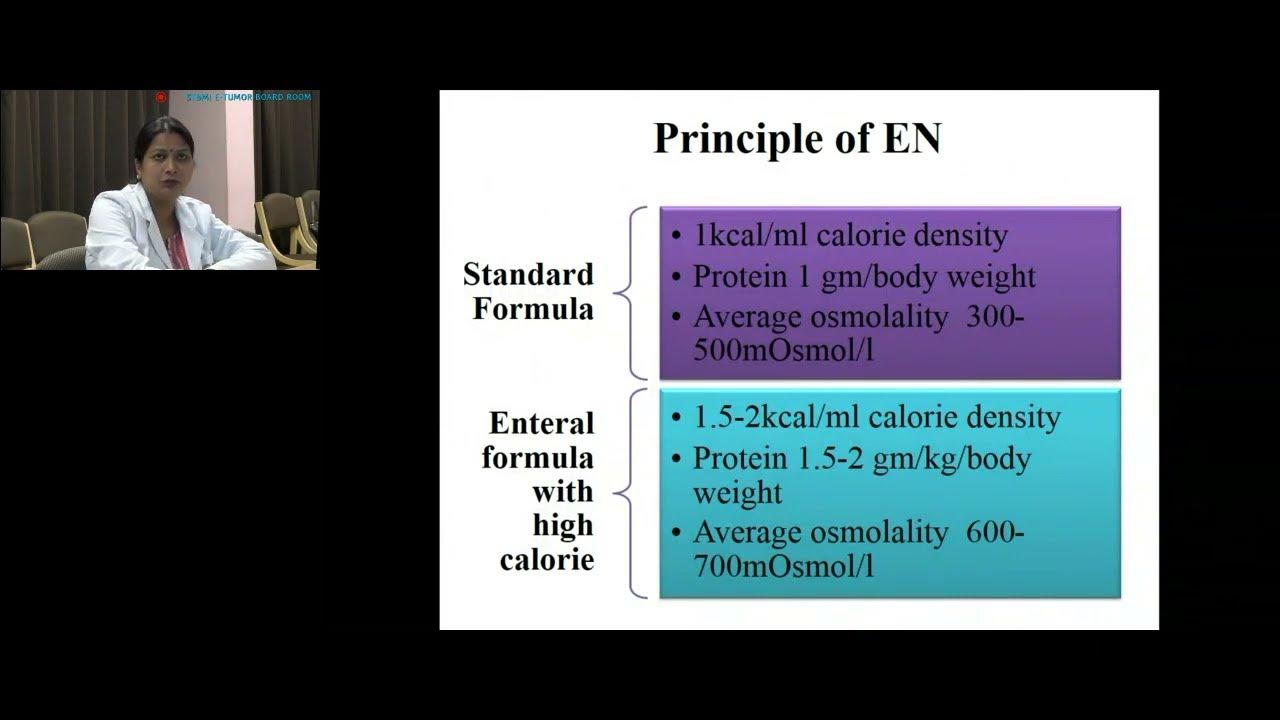When to Use Enteral Nutrition
Summary
TLDRThis video provides a comprehensive overview of enteral nutrition, a method of feeding patients unable to meet their nutritional needs orally. It covers the key terms, indications, and contraindications for providing enteral nutrition. The video explains that patients must be unable to consume enough calories and have a functional gastrointestinal system to be candidates for this feeding method. It also outlines conditions that prevent enteral nutrition, such as mechanical obstructions and severe gastrointestinal issues, and discusses ethical considerations for patients with terminal illnesses or advanced dementia.
Takeaways
- 📦 Enteral nutrition is the process of delivering nutrients directly into the stomach or small intestine, bypassing the mouth and esophagus.
- 🔄 Enteral nutrition is used when patients cannot eat enough to maintain body weight, but their gastrointestinal tract must be functional.
- ⚠️ Contraindications for enteral nutrition include any sign or medical condition that makes it unsafe, such as obstruction or malabsorption.
- 💉 Patients who are critically ill, have neurological disorders, or have mechanical dysfunctions in the GI tract often need enteral nutrition.
- 👶 Enteral nutrition can be given through a long tube placed in the nose/mouth or directly through the abdominal wall for long-term needs.
- 🚫 Contraindications include mechanical obstructions, hemodynamic instability, severe GI bleeds, or severe malabsorption.
- 🧠 Neurological conditions like stroke, brain injuries, Alzheimer's, and Parkinson's can make chewing or swallowing difficult, making enteral nutrition necessary.
- 🏥 Critically ill patients, especially those on ventilators, frequently require enteral nutrition due to their inability to eat.
- 📉 Malnutrition can be identified by significant unintentional weight loss or low calorie intake over a period of time.
- ⚖️ Enteral nutrition may not be appropriate for patients with advanced dementia or terminal illness as it may prolong suffering without improving quality of life.
Q & A
What is enteral nutrition, and how is it administered?
-Enteral nutrition is the process of delivering nutrients directly into the stomach or small intestine through a tube. It is used for patients who cannot consume enough calories by mouth to maintain body weight.
What are the two conditions that must be met for enteral nutrition to be indicated?
-First, the patient must be unable to consume enough calories by mouth to maintain body weight. Second, the patient must have a gastrointestinal tract that can safely receive nutrients, absorb them, and eliminate waste.
What are some common indications for enteral nutrition?
-Common indications include critically ill patients, those with neurological disorders, patients with mechanical dysfunction of the gastrointestinal tract, and those with low appetite due to diseases such as cancer.
What are contraindications for enteral nutrition?
-Contraindications include mechanical or functional obstruction of the gastrointestinal tract, hemodynamic instability (e.g., low blood pressure), severe gastrointestinal bleeding, and severe malabsorption.
Can patients with some ability to eat still qualify for enteral nutrition?
-Yes, a patient does not need to be unable to eat entirely to qualify for enteral nutrition. It is enough if they cannot meet their calorie needs through oral intake.
What are some examples of patients who might need enteral nutrition due to mechanical dysfunction?
-Patients with conditions like gastroesophageal reflux disease (GERD), malignancies, or trauma (e.g., a broken jaw) may have mechanical dysfunction that prevents normal eating and requires enteral nutrition.
Why is enteral nutrition often used for critically ill patients in intensive care?
-Critically ill patients, especially those on mechanical ventilation, are often unable to eat, and enteral nutrition provides a way to deliver essential nutrients without oral intake.
How can neurological disorders impact the need for enteral nutrition?
-Neurological disorders, such as stroke, traumatic brain injury, Alzheimer’s, or Parkinson’s disease, can impair a patient’s ability to chew or swallow, making enteral nutrition necessary.
What are the risks of providing enteral nutrition to a patient with severe malabsorption?
-Severe malabsorption can make enteral nutrition ineffective and dangerous, as it can lead to severe diarrhea, dehydration, and other complications such as cramping and bloating.
Why might enteral nutrition be avoided in patients with advanced dementia or terminal illness?
-In patients with advanced dementia or terminal illness, aggressive interventions like enteral nutrition may not improve outcomes and could prolong life without enhancing its quality, potentially increasing pain and suffering.
Outlines

هذا القسم متوفر فقط للمشتركين. يرجى الترقية للوصول إلى هذه الميزة.
قم بالترقية الآنMindmap

هذا القسم متوفر فقط للمشتركين. يرجى الترقية للوصول إلى هذه الميزة.
قم بالترقية الآنKeywords

هذا القسم متوفر فقط للمشتركين. يرجى الترقية للوصول إلى هذه الميزة.
قم بالترقية الآنHighlights

هذا القسم متوفر فقط للمشتركين. يرجى الترقية للوصول إلى هذه الميزة.
قم بالترقية الآنTranscripts

هذا القسم متوفر فقط للمشتركين. يرجى الترقية للوصول إلى هذه الميزة.
قم بالترقية الآن5.0 / 5 (0 votes)






